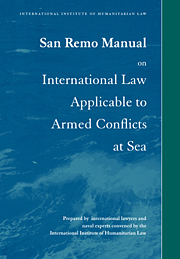 San Remo Manual on International Law Applicable to Armed Conflicts at Sea
San Remo Manual on International Law Applicable to Armed Conflicts at Sea Book contents
- Frontmatter
- Contents
- FOREWORD
- SAN REMO MANUAL
- Introductory note
- Part I General provisions
- Part II Regions of operations
- Part III Basic rules and target discrimination
- Part IV Methods and means of warfare at sea
- Part V Measures short of attack: interception, visit, search, diversion and capture
- Part VI Protected persons, medical transports and medical aircraft
- Annex: Series of meetings and contributions to the project
- EXPLANATION
- INDEX
Part II - Regions of operations
Published online by Cambridge University Press: 04 August 2010
- Frontmatter
- Contents
- FOREWORD
- SAN REMO MANUAL
- Introductory note
- Part I General provisions
- Part II Regions of operations
- Part III Basic rules and target discrimination
- Part IV Methods and means of warfare at sea
- Part V Measures short of attack: interception, visit, search, diversion and capture
- Part VI Protected persons, medical transports and medical aircraft
- Annex: Series of meetings and contributions to the project
- EXPLANATION
- INDEX
Summary
Section I Internal waters, territorial sea and archipelagic waters
14 Neutral waters consist of the internal waters, territorial sea, and, where applicable, the archipelagic waters, of neutral States. Neutral airspace consists of the airspace over neutral waters and the land territory of neutral States.
15 Within and over neutral waters, including neutral waters comprising an international strait and waters in which the right of archipelagic sea lanes passage may be exercised, hostile actions by belligerent forces are forbidden. A neutral State must take such measures as are consistent with Section II of this Part, including the exercise of surveillance, as the means at its disposal allow, to prevent the violation of its neutrality by belligerent forces.
16 Hostile actions within the meaning of paragraph 15 include, inter alia:
(a) attack on or capture of persons or objects located in, on or over neutral waters or territory;
(b) use as a base of operations, including attack on or capture of persons or objects located outside neutral waters, if the attack or seizure is conducted by belligerent forces located in, on or over neutral waters;
(c) laying of mines; or
(d) visit, search, diversion or capture.
17 Belligerent forces may not use neutral waters as a sanctuary.
18 Belligerent military and auxiliary aircraft may not enter neutral airspace. Should they do so, the neutral State shall use the means at its disposal to require the aircraft to land within its territory and shall intern the aircraft and its crew for the duration of the armed conflict.
- Type
- Chapter
- Information
- San Remo Manual on International Law Applicable to Armed Conflicts at SeaInternational Institute of Humanitarian Law, pp. 11 - 14Publisher: Cambridge University PressPrint publication year: 1995


